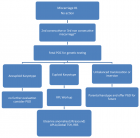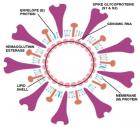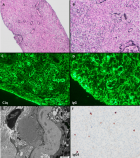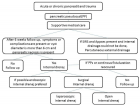Abstract
Case Report
Acute Kidney Injury due to spontaneous Atheroembolic disease, superimposed on diabetic nephropathy, with no recent vascular or cardiac intervention, presented as Rapidly Progressive Glomerulonephritis (RPGN)
Anas Diab*, Parravani Anthony, Hollie Berryman and Kareem Diab
Published: 14 July, 2021 | Volume 5 - Issue 2 | Pages: 053-055
Atheroembolic disease (AED), or Cholesterol Crystals Embolism, is a systemic disease presented as a complication of severe atherosclerosis [1], where older age, male sex, diabetes hypercholesterolemia, smoking and hypertension [2], are the main risk factors for the development of Atherosclerosis, it is known that spontaneous atherosclerotic renal disease is rare in the absence of any vascular intervention [3], and in the absence of anticoagulant [4], or the absence of calcified aorta, with the most common presentation of the disease is subacute kidney injury progress into renal dysfunction occurs in like a staircase pattern and the renal dysfunction is usually observed several weeks after a possible intervention, caused by dislodging the micro cholesterol plaques from a major artery, and start showering multiple organs causing micro and macro embolic phenomena.
In our case, we report acute kidney injury on a previously stable kidney disease in a female with diabetes mellitus type 2 presented with severe anemia, dyspnea, massive fluid overload with bilateral pleural effusion, patient had a history of multiple IV contrast exposures, with peripheral vascular occlusive disease (PVOD), required amputation of right below the knee amputation, presented during the COVID-19 pandemic, found with nephrotic syndrome, a kidney biopsy has shown cholesterol crystal embolization compatible with Athero-embolic Disease with severe Diabetic Nephropathy.
Read Full Article HTML DOI: 10.29328/journal.jcn.1001074 Cite this Article Read Full Article PDF
References
- Kronzon I, Saric M. Cholesterol embolization syndrome. Circulation 2010; 122: 631-641. PubMed: https://pubmed.ncbi.nlm.nih.gov/20697039/
- Tanaka H, Yamana H, Matsui H, Fushimi K, Yasunaga H, et al. Proportion and risk factors of cholesterol crystal embolization after cardiovascular procedures: a retrospective national database study. Heart Vessels 2020; 35:1250-1255. PubMed: https://pubmed.ncbi.nlm.nih.gov/32277287/
- Nickol J, Richards T, Mullins J. Cholesterol Embolization Syndrome From Penetrating Aortic Ulcer. Cureus 2020; 12: e8670. PubMed: https://www.ncbi.nlm.nih.gov/pmc/articles/PMC7370687/
- Muller-Hansma AHG, Daemen-Gubbels CRGM, Schut NH. Cholesterol embolisms as possible adverse drug reaction of direct oral anticoagulants. Neth J Med 2018; 76:125-128. PubMed: https://pubmed.ncbi.nlm.nih.gov/29667588/
- Scolari F, Ravani P. Atheroembolic renal disease. Lancet 2010; 375: 1650-1660. PubMed: https://pubmed.ncbi.nlm.nih.gov/20381857/
- Cosio FG, Zager RA, Sharma HM. Atheroembolic renal disease causes hypocomplementaemia. Lancet 1985; 2: 118-121. PubMed: https://pubmed.ncbi.nlm.nih.gov/2862317/
- Ridker PM, Cannon CP, Morrow D, Rifai N, Rose LM, et al. C-reactive protein levels and outcomes after statin therapy. N Engl J Med. 2005; 352: 20-28. PubMed: https://pubmed.ncbi.nlm.nih.gov/15635109/
- Vaidya PN, Finnigan NA. Atheroembolic Kidney Disease. 2021. PubMed: https://pubmed.ncbi.nlm.nih.gov/29494024/
- Matsumura T, Matsumoto A, Ohno M, Suzuki S, Ohta M, et al. A case of cholesterol embolism confirmed by skin biopsy and successfully treated with statins and steroids. Am J Med Sci 2006; 331: 280-283. PubMed: https://pubmed.ncbi.nlm.nih.gov/16702800/
Figures:
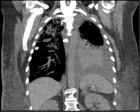
Figure 1

Figure 2
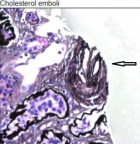
Figure 3
Similar Articles
-
The Risk-Adjusted Impact of Intraoperative Hemofiltration on Real-World Outcomes of Patients Undergoing Cardiac SurgeryMatata BM*,Shaw M. The Risk-Adjusted Impact of Intraoperative Hemofiltration on Real-World Outcomes of Patients Undergoing Cardiac Surgery. . 2017 doi: 10.29328/journal.jcn.1001001; 1: 001-010
-
Cardiac Manifestations on Anti-Phospholipid SyndromeFaisal AH*. Cardiac Manifestations on Anti-Phospholipid Syndrome. . 2017 doi: 10.29328/journal.jcn.1001002; 1: 011-013
-
Intraperitoneal and Subsequent Intravenous Vancomycin: An Effective Treatment Option for Gram-Positive Peritonitis in Peritoneal DialysisBarone RJ*,Gimenez NS,Ramirez L. Intraperitoneal and Subsequent Intravenous Vancomycin: An Effective Treatment Option for Gram-Positive Peritonitis in Peritoneal Dialysis. . 2017 doi: 10.29328/journal.jcn.1001003; 1: 014-018
-
Acute Tubulointerstitial Nephritis due to Phenytoin: Case ReportNilzete Liberato Bresolin*,Pedro Docusse Junior,Maria Beatriz Cacese Shiozawa,Marina Ratier de Brito Moreira,Natalia Galbiatti Silveira. Acute Tubulointerstitial Nephritis due to Phenytoin: Case Report. . 2017 doi: 10.29328/journal.jcn.1001004; 1: 019-025
-
Profile of vitamin D receptor polymorphism Bsm I and FokI in end stage renal disease Egyptian patients on maintenance hemodialysisEL-Attar HA*,Mokhtar MM,Gaber EW. Profile of vitamin D receptor polymorphism Bsm I and FokI in end stage renal disease Egyptian patients on maintenance hemodialysis. . 2017 doi: 10.29328/journal.jcn.1001005; 1: 026-040
-
Anemia response to Methoxy Polyethylene Glycol-Epoetin Beta (Mircera) versus Epoetin Alfa (Eprex) in patients with chronic Kidney disease on HemodialysisAlaa K Dhayef*,Jawad K Manuti,Abdulwahab S Abutabiekh. Anemia response to Methoxy Polyethylene Glycol-Epoetin Beta (Mircera) versus Epoetin Alfa (Eprex) in patients with chronic Kidney disease on Hemodialysis. . 2017 doi: 10.29328/journal.jcn.1001006; 1: 041-047
-
The outcome of Acute Kidney Injury in patients with severe MalariaJoão Egidio Romão Jr*,João Alberto Brandão. The outcome of Acute Kidney Injury in patients with severe Malaria. . 2017 doi: 10.29328/journal.jcn.1001007; 1: 048-054
-
Short term effect of Intravenous Intermittent Iron Infusion versus Bolus Iron Infusion on Iron parameters in Hemodialysis patientsIman Ibrahim Sarhan,Hussein Sayed Hussein,Islam Omar Elshazly*,Mahmoud Salah Hassan. Short term effect of Intravenous Intermittent Iron Infusion versus Bolus Iron Infusion on Iron parameters in Hemodialysis patients. . 2017 doi: 10.29328/journal.jcn.1001008; 1: 055-059
-
Association between bh4/bh2 ratio and Albuminuria in Hypertensive Type -2 Diabetic patientsJose Aviles-Herrera,Karla C Arana-Pazos,Leonardo Del Valle-Mondragon,Carolina Guerrero-García,Alberto Francisco Rubio-Guerra*. Association between bh4/bh2 ratio and Albuminuria in Hypertensive Type -2 Diabetic patients. . 2017 doi: 10.29328/journal.jcn.1001009; 1: 060-063
-
Posterior Reversible Leukoencephalopathy Syndrome in a patient after second dose of Rituximab for treatment of resistant Thrombotic Thrombocytopenic PurpuraSabaa Asif*,Sumbal Nasir Mahmood,Osama Kunwer Naveed. Posterior Reversible Leukoencephalopathy Syndrome in a patient after second dose of Rituximab for treatment of resistant Thrombotic Thrombocytopenic Purpura . . 2018 doi: 10.29328/journal.jcn.1001010; 2: 001-004
Recently Viewed
-
Peripheral perfusion index in critically ill COVID-19 and its association with multiorgan dysfunctionCornu Matias German*, Tonelier Matias, Roel Pedro, Sanhueza Laura, Orozco Sergio Martin, Sepulveda Mariana Elizabet, Svampa Silvana Enrica, Arana Osorio Erick and Martinuzzi Andres Luciano Nicolas. Peripheral perfusion index in critically ill COVID-19 and its association with multiorgan dysfunction. J Clin Intensive Care Med. 2023: doi: 10.29328/journal.jcicm.1001043; 8: 004-013
-
Dalbavancin and moleculight in the COVID-19 pandemicWayne J Caputo*, George Fahoury, Donald Beggs, Patricia Monterosa. Dalbavancin and moleculight in the COVID-19 pandemic. J Clin Intensive Care Med. 2023: doi: 10.29328/journal.jcicm.1001042; 8: 001-003
-
Development of Latent Fingerprints Using Food Coloring AgentsKallu Venkatesh,Atul Kumar Dubey,Bhawna Sharma. Development of Latent Fingerprints Using Food Coloring Agents. J Forensic Sci Res. 2024: doi: 10.29328/journal.jfsr.1001070; 8: 104-107
-
Crime Scene Examination of Murder CaseSubhash Chandra*,Pradeep KR,Jitendra P Kait,SK Gupta,Deepa Verma. Crime Scene Examination of Murder Case. J Forensic Sci Res. 2024: doi: 10.29328/journal.jfsr.1001071; 8: 108-110
-
Challenges and Concerns of Parents with Children with Down Syndrome. Challenges and Concerns of Parents with Children with Down Syndrome. Arch Psychiatr Ment Health. 2023: doi: 10.29328/journal.apmh.1001048; 7: 015-017
Most Viewed
-
Evaluation of Biostimulants Based on Recovered Protein Hydrolysates from Animal By-products as Plant Growth EnhancersH Pérez-Aguilar*, M Lacruz-Asaro, F Arán-Ais. Evaluation of Biostimulants Based on Recovered Protein Hydrolysates from Animal By-products as Plant Growth Enhancers. J Plant Sci Phytopathol. 2023 doi: 10.29328/journal.jpsp.1001104; 7: 042-047
-
Sinonasal Myxoma Extending into the Orbit in a 4-Year Old: A Case PresentationJulian A Purrinos*, Ramzi Younis. Sinonasal Myxoma Extending into the Orbit in a 4-Year Old: A Case Presentation. Arch Case Rep. 2024 doi: 10.29328/journal.acr.1001099; 8: 075-077
-
Feasibility study of magnetic sensing for detecting single-neuron action potentialsDenis Tonini,Kai Wu,Renata Saha,Jian-Ping Wang*. Feasibility study of magnetic sensing for detecting single-neuron action potentials. Ann Biomed Sci Eng. 2022 doi: 10.29328/journal.abse.1001018; 6: 019-029
-
Pediatric Dysgerminoma: Unveiling a Rare Ovarian TumorFaten Limaiem*, Khalil Saffar, Ahmed Halouani. Pediatric Dysgerminoma: Unveiling a Rare Ovarian Tumor. Arch Case Rep. 2024 doi: 10.29328/journal.acr.1001087; 8: 010-013
-
Physical activity can change the physiological and psychological circumstances during COVID-19 pandemic: A narrative reviewKhashayar Maroufi*. Physical activity can change the physiological and psychological circumstances during COVID-19 pandemic: A narrative review. J Sports Med Ther. 2021 doi: 10.29328/journal.jsmt.1001051; 6: 001-007

HSPI: We're glad you're here. Please click "create a new Query" if you are a new visitor to our website and need further information from us.
If you are already a member of our network and need to keep track of any developments regarding a question you have already submitted, click "take me to my Query."






